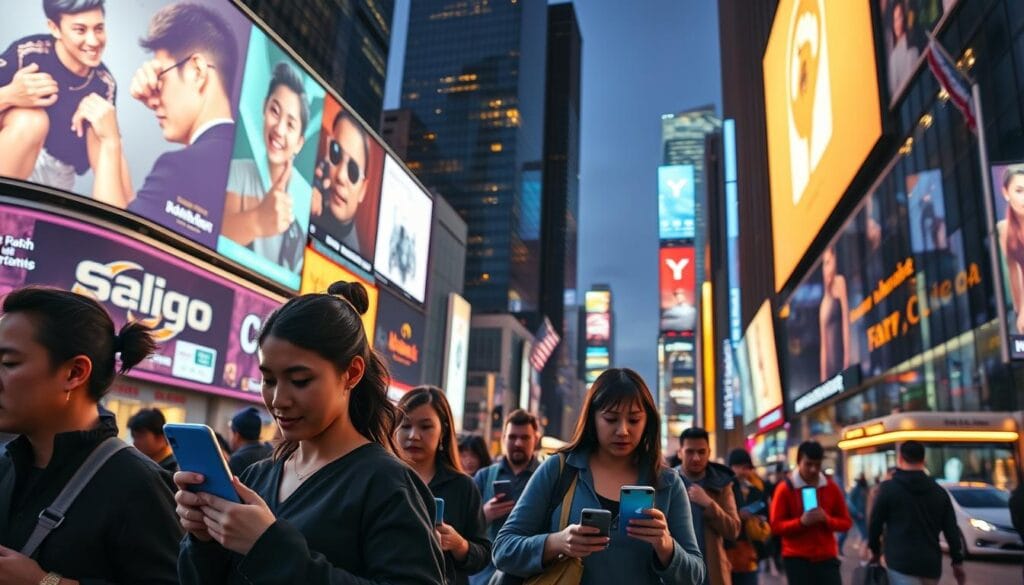Surprising fact: the affiliate industry is set to hit $12 billion globally by 2025, even as paid media costs spike and ROI gets harder to predict.
Paid channels are volatile. Every dollar must show impact. We see elite brands shifting to outcome-first partnerships that lock in performance certainty.
We are Macro Webber. We combine data, proven systems, and real examples to turn creator-led social proof and mobile-first funnels into predictable revenue.
Expect 2025 to favor rigorous partner vetting, brand-safe narratives, and commission models built for high-ticket offers. Our WebberXSuite™ and the A.C.E.S. Framework map affiliates to LTV and payback windows.
This section previews practical levers—first-party data capture, SEO-driven content, and creator funnels that convert in seconds—so leadership can move from testing to dominance.
Key Takeaways
- Performance certainty matters: shift budgets to outcome-based partnerships.
- Creator-led proof: social proof will drive mobile-first conversions.
- Systems win: use frameworks that link partners to LTV and payback.
- High-ticket playbook: protect brand equity with vetted, compliant partners.
- Measurement that matters: report incrementality, assisted conversions, and blended CAC.
- Act now: explore our Growth Blueprint or book a consultation to secure scalable impact.
Market Outlook for 2025 and Beyond: Size, Growth Drivers, and Where India Fits In
Rapid smartphone adoption and social commerce are opening a rare runway for premium brands. We frame macro numbers into tactical steps that C-level leaders can act on now.

Data check
The global affiliate industry is forecast at $12 billion in 2025 while India is on a $639M trajectory by 2026. This gap signals headroom for premium brands to capture market share with focused playbooks.
Growth drivers
Smartphone penetration, faster ecommerce funnels, and creator-led social proof are lifting conversion velocity. Buyers ignore blunt ads and respond to trusted voices and one-click checkout paths.
“Mobile-first experiences and creator trust will decide high-ticket wins.”
Practical implications
- Design dynamic commission tiers for high-ticket products and LTV-aligned payouts.
- Blend mature partners with high-impact creators to balance scale and brand positioning.
- Diversify networks, add direct partnerships, and build private marketplaces to protect data and rates.
| Metric | Global (2025) | Local trajectory (2026) | Strategic lever |
|---|---|---|---|
| Market size | $12B | $639M | Priority: premium category rollouts |
| Conversion drivers | Creator proof, mobile UX | Mobile-first funnels | One-click, deep links, fast pages |
| Revenue mix | Scale + creators | High AOV focus | Dynamic commissions, LTV bonuses |
- Pilot quickly, measure incrementality, then scale to multi-million revenue lanes in 2–3 quarters.
- Enforce brand controls and disclosure compliance to protect reputation.
Consumers Are Informed, Skeptical, and Mobile-First
Mobile behavior has rewritten how buyers vet products and whom they trust. Today’s consumers scroll rapidly, compare sources, and ignore blunt media. They favor voices that feel peer-like and honest.

Trust over ads: Why social proof from creators outperforms traditional media
Creator endorsements beat interruptive ads because they provide niche authority, context-rich stories, and relatable proof that lowers buyer anxiety.
We design creator scripts that surface use-cases, objections, and live demos. Audiences respond when content feels like a recommendation from a trusted peer rather than a polished commercial.
“Social proof compresses consideration and raises conversion lift when paired with fast checkout.”
Designing mobile-first affiliate journeys: fast pages, deep links, one-click checkout
Execution matters: sub-2s page loads, deep links to app product pages, and one-click checkout cut drop-off and shorten time-to-purchase.
- Use vertical video and tap-to-reveal benefits for quick comprehension.
- Embed affiliate links with clean UTMs and explicit disclosures to preserve UX and trust.
- Align SEO with mobile intent: review schema, FAQs, and internal links to boost organic lift.
We recommend CRO sprints that track scroll depth, tap maps, and payment friction. Small, iterative wins compound into predictable sales velocity for premium products.
Video Commerce, Livestream Shopping, and the Creator-Led Sales Funnel
Real-time video blends trust and scarcity to accelerate high-AOV sales. Live formats now convert attention into purchases with measurable speed.
We map formats to funnel roles: reels ignite discovery, short clips build intent, Lives close with urgency, and VOD demos support long-tail purchase decisions.
Campaign mechanics must be precise. Use exclusive codes, cart timers, limited drops, and backstage access to trigger commitment.
Coach creators to structure Lives: hook in 10 seconds, demo benefits, handle objections, then run a brief FAQ. This sequence raises conversion and reduces return rates.
“Partnering with creators who host TikTok Live or Instagram Live, supported by exclusive discount codes, helps track performance and drive real-time conversions.”
Trackable architecture is non-negotiable. Tag links, issue unique codes per host, and feed cohorts to dashboards that show which format and theme drove sales and repeat purchases.
- Align brand creative with creator authenticity via lightweight guidelines and pre-cleared claims.
- Build retention loops: onboarding videos, VIP groups, and member-only promos to lift LTV.
- Test platforms—TikTok Live vs. Instagram Live vs. YouTube Live—to find the highest AOV and repeat patterns.
Finally, integrate your affiliate program incentives with livestream KPIs: watch time, add-to-cart rate, and day‑7 repeat sales. We recommend rapid pilots, clear measurement, and scaling only after incrementality is proven.
Privacy-First Tracking, Cookie Deprecation, and First-Party Data Strategy
Browsers are shutting off third-party identifiers, forcing a rethink of how we prove value. We must build consented identity and durable attribution that preserves margin and trust.
Our decisive plan: assemble a first-party data spine, deploy cookieless methods, and lock disclosure compliance into every partner flow.
We begin with a clean architecture: consented email capture, server-side tagging, and privacy-safe event streams feeding a unified attribution layer. This approach protects revenue and future-proofs affiliate marketing measurement.
- Cookieless attribution: signed links, coupon-level tracking, and clean-room matching maintain accuracy across devices.
- Compliance and trust: standardized disclosures, automated insertion into links, and periodic audits protect brands and creators.
- Commission fidelity: tie payouts to verified net-new customers, returns-adjusted windows, and clear fraud rules.
- Operational sync: unify affiliate networks and direct partners into a single source of truth via WebberXSuite™ to resolve identity gaps.
- Resilience plays: email and SMS welcome flows triggered by creator clicks, preserving conversion when cookies fail.
“First-party identity is the only durable pathway to protect margin and remain compliant.”
| Method | Primary Benefit | Verification | Implementation Effort |
|---|---|---|---|
| Consented email capture | Durable user ID for cross-session attribution | Double opt-in, hashed sigs | Medium |
| Signed links & coupon codes | Cookieless conversion tracking | Unique code mapping | Low |
| Server-side tagging + clean rooms | Privacy-safe event reconciliation | Matched cohorts, runbooks | High |
| Commission rules & audit gates | Protects revenue and brand | Return-adjusted payouts | Low–Medium |
Action for leaders: greenlight a 90-day sprint to deploy the data spine, test signed links across top partners, and publish disclosure templates. This reduces risk and keeps conversions steady as cookies disappear.
Affiliate Marketing Trends India
Smartphone-first shoppers and vernacular creators are reshaping how premium brands win buyers.
We see clear growth levers: creator trust, regional content, and mobile-native journeys that compress decisions.
Practical tests for executives:
- Live shopping pilots: festival drops, creator-hosted reveals, and micro-community takeovers tailored to local calendars.
- Payment-first UX: deep links to app PDPs, UPI-friendly checkout, and COD-aware messaging to lift conversion.
- Content frameworks: comparisons, how-tos, and real-life demos that map to high-margin categories.
We prioritize first-party capture—lead magnets, sample requests, and waitlists—to protect attribution as cookies fade.
Opportunities for premium brands: set standards in creator care with fair commissions, fast payouts, and exclusive early access to build lasting partnerships.
- Test fast pilots, measure incrementality, then scale the winners.
- Invest in evergreen review hubs and intent clusters to compound organic growth.
Convergence of Influencer and Affiliate, Plus New Models Beyond Creators
Channels are merging: creators who once built only buzz now close deals in real time.
We view the full funnel as integrated. Influencers drive consideration and can now convert. At the same time, affiliates build persistent awareness and discovery for expensive products.
Leaders should adopt a diversified affiliate program that mixes creators, publishers, community leaders, and commerce partners. This compounds reach and improves sales velocity.
- Roles redefined: pay for conversions and reward awareness flights.
- Post-purchase referrals: automated invites, gift credits, and VIP tiers to turn customers into revenue channels.
- Engagement standards: SLAs for content quality, cadence, and audience interaction that lift conversion.
“Expand beyond a single channel: networks help discover partners; direct relationships protect data and margin.”
We formalize compensation with hybrid fees, commission windows, and milestone bonuses. This gives marketers and affiliate marketers a unified, measurable growth engine that leadership can sign off on.
2025 Playbook: AI Optimization, SEO, and Content Strategies for Scalable Growth
We deliver an execution-ready blueprint that couples AI with SEO and content to scale predictable revenue. This is tactical: find high-fit partners, build compounding assets, and align payouts to margin.
AI-powered partner vetting and dynamic scaling
AI now scans partners at scale to produce brand-fit scores, fraud flags, and dynamic tiering. Tools reduced recruitment time and added quality partners at pace in real-world pilots.
SEO and compounding content systems
We craft topic clusters with intent-led reviews and comparisons. Structured data and internal links lift categories, while long-form and short social cuts reuse the same narrative for conversions.
Measurement, commissions, and brand values
Define LTV, payback windows, and assisted-conversions attribution that the CFO trusts. Set category-based commission and new-customer bonuses to protect margin.
Integrate values: cause-driven partnerships boost engagement—66% of buyers pay more for sustainable brands—and lift long-term income.
- Operationalize AI discovery, score partners, then pilot dynamic commission tiers.
- Build SEO ecosystems and reuse core content for creators and email drips.
- Measure LTV, assisted sales, and adjust commission to reward real incrementality.
Conclusion
A tight operating system that unifies content, social media, and attribution turns short tests into durable revenue.
We must align creator trust with precise commission rules, privacy-safe data, and mobile-first checkout to win premium demand.
Now is the window: video-first commerce and cookieless attribution create urgency for bold action.
Lock your affiliate program design, deploy data-backed strategy, and run event playbooks for shopping moments.
Act fast: secure Macro Webber’s Growth Blueprint and book a priority consultation. Slots are limited to protect performance and ensure speed to income.



